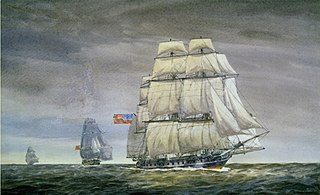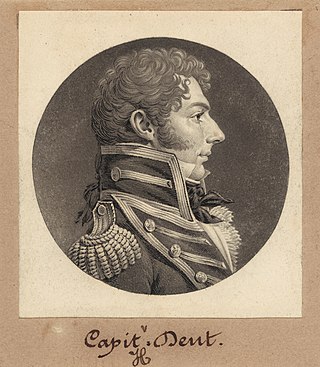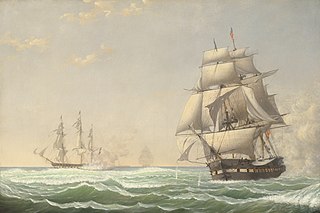
William Bainbridge was a Commodore in the United States Navy. During his long career in the young American Navy he served under six presidents beginning with John Adams and is notable for his many victories at sea. He commanded several famous naval ships, including USS Constitution, and saw service in the Barbary Wars and the War of 1812. Bainbridge was also in command of USS Philadelphia when she grounded off the shores of Tripoli, Libya in North Africa, resulting in his capture and imprisonment for many months. In the latter part of his career he became the U.S. Naval Commissioner.

USS Adams was a 28-gun (rated) sailing frigate of the United States Navy. She was laid down in 1797 at New York City by John Jackson and William Sheffield and launched on 8 June 1799. Captain Richard Valentine Morris took command of the ship.

Master Commandant William Henry Allen was an American naval officer during the War of 1812.

James Lawrence was an officer of the United States Navy. During the War of 1812, he commanded USS Chesapeake in a single-ship action against HMS Shannon, commanded by Philip Broke. He is probably best known today for his last words, "Don't give up the ship!", uttered during the capture of the Chesapeake. The quotation is still a popular naval battle cry, and was invoked in Oliver Hazard Perry's personal battle flag, adopted to commemorate his dead friend.

The second USS Hamilton (DD–141) was a Wickes-class destroyer in the United States Navy following World War I, later reclassified DMS-18 for service in World War II.
Four ships in the United States Navy have been named USS Sampson for Rear Admiral William T. Sampson (1840–1902), known for his victory in the Battle of Santiago de Cuba during the Spanish–American War.

John Herbert Dent was an officer in the United States Navy during the Quasi-War, the First Barbary War, and the War of 1812. He was acting captain on the USS Constitution" during the attacks on Tripoli in 1804.
Lieutenant Fitz Henry Babbitt was an officer of the United States Navy who served during the War of 1812, and was killed during the capture of USS President.
Several ships of the British Royal Navy have been named HMS Charlestown

The first John Adams was originally built in 1799 as a frigate for the United States Navy, converted to a corvette in 1809, and later converted back to a frigate in 1830. Named for American Founding Father and president John Adams, she fought in the Quasi-War, the First and Second Barbary Wars, the War of 1812, the Mexican–American War and the American Civil War. At the end of her career, she participated in the Union blockade of South Carolina's ports. She then participated in the raid on Combahee Ferry that Harriet Tubman, the former slave and Union operative, organized with Union colonel Montgomery. John Adams led three steam-powered gunboats up the Harbor River to Port Royal. The squadron relied on local black mariners to guide it past mines and fortifications. The squadron freed 750+ slaves and unsettled the Confederacy. Tubman was the first woman in U.S. history to plan and execute an armed expedition.
The second USS General Greene was a frigate in the United States Navy during the Quasi-War with France.

The capture of USS President was one of many naval actions fought at the end of the War of 1812. The frigate USS President tried to break out of New York Harbor but was intercepted by a British squadron of four warships and forced to surrender.

HMS Endymion was a 40-gun fifth rate that served in the French Revolutionary Wars, the Napoleonic Wars, the War of 1812 and during the First Opium War. She was built to the lines of the French prize Pomone captured in 1794. Due to her exceptional handling and sailing properties, the Severn-class frigates were built to her lines, although the gunports were rearranged to mount an extra pair of guns per side, the ships were made of softwood and were not built until nearly the end of the Napoleonic Wars.
Two ships of the Royal Navy have borne the name HMS Detroit, after Fort Detroit. Both served on Lake Erie during the War of 1812:
During the French Revolutionary and Napoleonic Wars Égyptienne, or Egypt, which commemorated Napoleon's Egyptian Campaign, was a popular name for French vessels, including naval vessels and privateers. Between 1799 and 1804, warships of the Royal Navy captured one French frigate and five different French privateers all with the name Égyptienne, and at least one privateer with the name Égypte.
Three vessels of the Royal Navy have borne the name HMS Thorn:
This page is based on this
Wikipedia article Text is available under the
CC BY-SA 4.0 license; additional terms may apply.
Images, videos and audio are available under their respective licenses.








